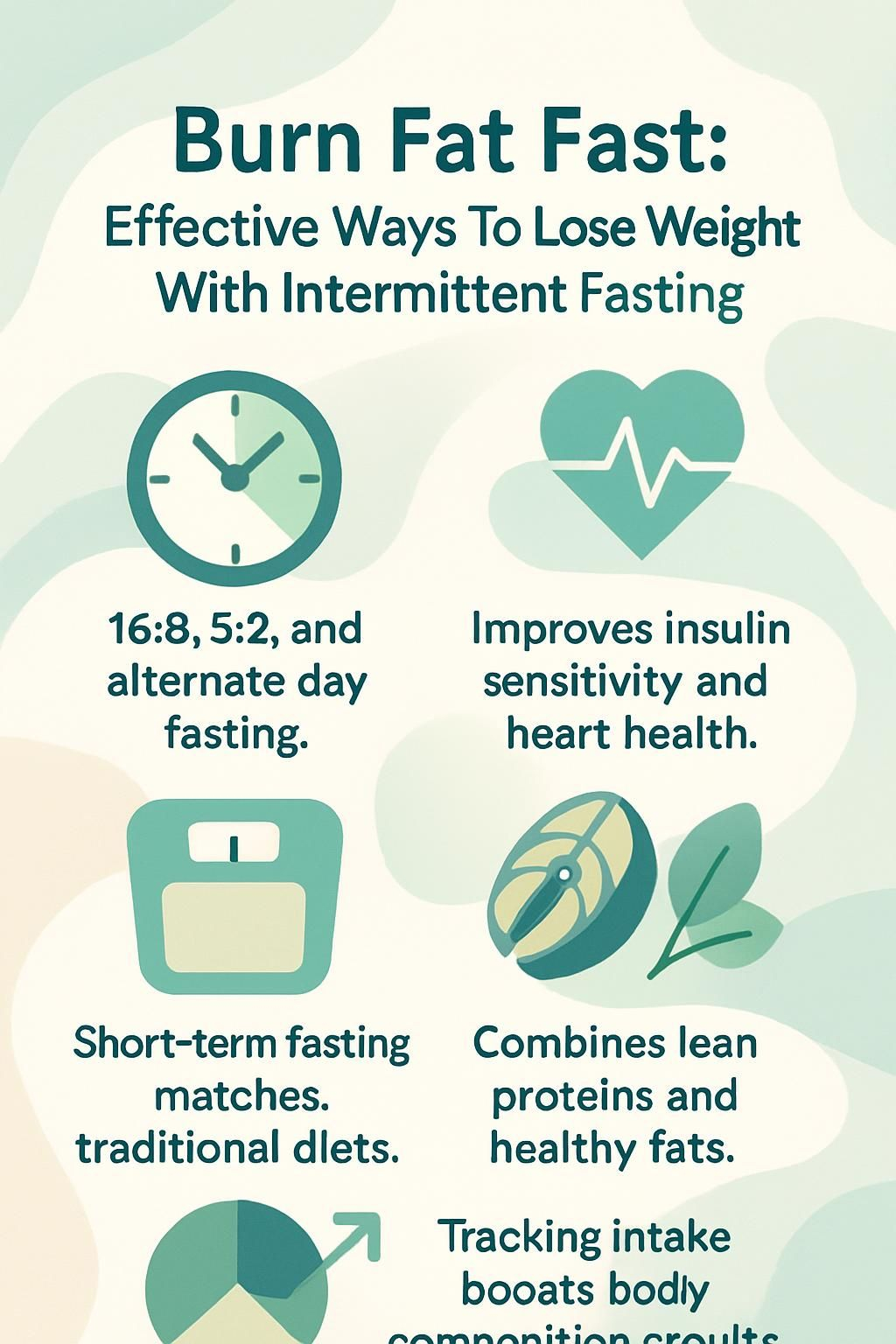Burn Fat Fast: Effective Ways To Lose Weight With Intermittent Fasting
Our Nutrition Assistant AI Suite will transform your body. You will lose fat, get toned, and build muscle. Gain confidence and optimal health.
Losing weight can feel hard, even with a careful diet and regular exercise. Intermittent fasting, an eating schedule that cycles between eating and fasting, is a practical way to help you lose weight and burn fat. This guide shows simple ways to start, how to fit fasting into daily life, and what the science says about results.
You will learn which fasting schedules work, how to build meals that keep you full, and how to stay motivated. Intermittent fasting can help you eat fewer calories without counting every bite. With a smart plan and steady habits, you can make real progress.
Key Takeaways
- Popular intermittent fasting schedules, like 16:8, 5:2, and alternate day fasting, help create a calorie deficit that supports fat loss.
- Research from major health systems suggests fasting may improve insulin sensitivity, a measure of how well your body uses sugar, and reduce risk factors linked to heart disease and type 2 diabetes.
- Short-term intermittent fasting, about 3 to 6 months, often matches continuous calorie restriction for weight loss results in clinical studies.
- Eating nutrient-dense foods during eating windows, including lean protein, whole grains, healthy fats, fruits, and vegetables, supports steady progress.
- Self-monitoring, such as food logs, step counts, and wearable trackers, improves adherence and can lead to better body composition.

Definition and overview of intermittent fasting
Intermittent fasting is an eating pattern that switches between set hours for eating and hours without food. The 16:8 method is common. You fast for 16 hours, then eat your meals within an 8-hour window each day.
Other options include the 5:2 plan, where you eat normally for five days and lower calories on two nonconsecutive days, and alternate day fasting, which repeats a fasting day followed by a regular day. Short-term trials show intermittent fasting can match a daily low-calorie diet for weight loss.
Instead of focusing only on what to eat, you also focus on when to eat. Many medical centers note potential benefits for weight management and metabolic health. Early evidence suggests it may lower risks tied to obesity, diabetes, and heart disease.
Intermittent fasting gives your body longer breaks between meals, which can make it easier to use stored fat for energy.
Importance of weight loss and fat burning
Reducing excess weight helps lower your risk of heart disease, type 2 diabetes, and certain cancers. Trimming belly fat is especially helpful, since abdominal fat is linked to higher health risks.
Losing even 10 pounds can improve your body mass index and ease stress on your heart and joints. Pairing smart nutrition with regular activity supports lasting results. Whole grains, lean protein, and healthy fats can steady appetite and limit extra calories from processed foods.
Exercise helps you burn more calories, and strength training protects muscle mass, which keeps your metabolism steady. These habits reduce the chance of weight regain.
Brief summary of the benefits of intermittent fasting for weight loss
Intermittent fasting helps you create a calorie deficit, which supports fat loss. Many people find it easier to eat fewer calories when the eating window is shorter. Studies also report improvements in insulin sensitivity and other markers of metabolic health.
You can choose a schedule that fits your routine, such as 16:8 or alternate day fasting. During fasting hours, your body draws more energy from stored fat, including fat around the abdomen. Tracking meals and sticking to nutrient-dense foods can improve consistency and results.
Next, you will see how the main fasting schedules work and what happens in your body during a fast.
Understanding Intermittent Fasting

Many people use intermittent fasting to support weight loss and burn fat. Understanding how schedules differ, and what they do inside your body, helps you choose a plan you can keep.
Explanation of different types of intermittent fasting schedules (e.g., 16/8, 5:2, alternate day fasting)
Each schedule uses meal timing to reduce calories while preserving a simple routine. Pick one that fits your day and preferences.
- The 16:8 method: fast for 16 hours, then eat within an 8-hour window, for example 12 p.m. to 8 p.m. It can curb late-night snacking and simplify meals.
- The 5:2 diet: eat your usual intake on five days, then lower calories to about 500 to 600 on two nonconsecutive days. Many people like the weekly flexibility.
- Alternate day fasting: fast every other day, sometimes allowing about 20 to 30 percent of usual calories on fasting days. Studies show it can support fat loss and improve insulin sensitivity.
- Time-restricted eating: limit daily eating to a set window, such as 6 to 10 hours. Shorter windows may help appetite control.
- Eat Stop Eat: complete a 24-hour fast once or twice per week. This creates a larger calorie gap but needs careful planning.
- Match your schedule to your training, family time, and energy needs. A dietitian can help you personalize protein, fiber, and nutrient targets.
All of these plans can be safe and effective if you eat balanced meals, stay hydrated, and adjust the schedule as needed.
Discussing the science behind fasting and its effects on fat loss
After about 12 hours without food, your body uses most of its stored sugar, called glycogen. As glycogen falls, your body increases fat burning for fuel, a process called lipolysis. This shift helps reduce body weight and body fat.
Fasting also changes hormones. Insulin, a hormone that helps move sugar from blood into cells, tends to drop during a fast. Lower insulin makes it easier to use stored fat. Appetite hormones such as leptin and ghrelin adjust as well, which can reduce cravings for many people.
Research reviews report that intermittent fasting, over several weeks, often matches a daily low-calorie diet for weight loss. Adding light to moderate aerobic exercise supports blood pressure and other metabolic markers.
Fasting can make the body more efficient at using its own fat for energy, notes researcher Dr. Krista Varady.
Strength training helps preserve muscle mass during weight loss. Keeping muscle is important because it helps maintain your daily calorie burn.
Benefits of Intermittent Fasting for Weight Loss
Intermittent fasting can help you burn fat faster while supporting a healthy weight. Think of it as a simple structure that keeps your intake in check, day after day.
Enhanced fat burning and metabolic changes during fasting
During a fast, your body relies more on stored fat for energy. Exercise performed near the end of a fast may increase this effect, since insulin levels are lower and fat is easier to access.
Regular activity speeds the shift from burning stored sugar to burning fat. Aim for consistent movement to support both fat loss and fitness while you practice a 16-hour fast or a similar plan.
Improved insulin sensitivity and hormonal balance
Better insulin sensitivity means your body needs less insulin to handle blood sugar. Intermittent fasting often improves this measure over time. With lower insulin, your body can tap stored fat more readily.
Fasting schedules also affect hunger hormones. Many people notice fewer cravings after the first week. This makes it easier to stick with your plan and keep portions steady.
Potential mental and physical health benefits
Weight loss with fasting can support heart health by improving blood pressure, waist size, and other risk markers. Some people also report clearer thinking and steadier energy.
Balanced meals, enough water, and regular sleep strengthen these benefits. Healthy habits work together, which helps you keep results long term.
Getting Started with Intermittent Fasting
You can start small and still see progress. A clear goal and a realistic schedule make fasting easier to follow.
Setting realistic weight loss goals
Aim to lose about 1 to 2 pounds per week through intermittent fasting and balanced meals. This pace protects muscle mass and supports a healthy metabolism.
Set short milestones, such as 4 to 8 pounds in a month, and track habits you can control. Include lean protein and fiber to stay full while you lose fat.
Choosing the right fasting schedule for your lifestyle
Match the plan to your day. The 16:8 method fits many work and school routines since you can skip breakfast or stop eating after dinner. The 5:2 plan offers weekly flexibility. Alternate day fasting suits people who prefer firmer structure.
Check with a healthcare professional before starting if you are pregnant, have diabetes, take medications, have a history of eating disorders, or have heart or kidney concerns. The best schedule is the one you can keep safely.
Tips for easing into intermittent fasting
- Start with a 12-hour fast, such as 7 p.m. to 7 a.m., then extend your fasting window by 30 to 60 minutes every few days.
- Pay attention to how you feel. If fatigue or headaches persist, shorten the fast and build back slowly.
- Prioritize nutrient-dense meals during eating windows. Include protein, colorful vegetables, fruit, whole grains, and healthy fats.
- Drink water often. Plain coffee or unsweetened tea can help curb hunger during fasting hours.
- Set steady, weekly goals. Small wins keep motivation high.
- Pick a schedule that fits work, school, and social events so you can be consistent.
- Plan distractions for hunger waves, such as a short walk or a quick task.
- Track energy, mood, and sleep in a simple log to spot helpful patterns.
- If severe hunger or lightheadedness continues despite hydration, reduce fasting time and reassess your meals.
- Speak with a clinician before major changes if you have medical conditions or take prescription drugs.
Most people adjust within one to two weeks. Gentle progress helps you stick with the plan.
Incorporating Healthy Foods During Eating Windows
What you eat still matters. Nutrient-dense foods help you feel full, protect muscle, and make each calorie count.
The importance of nutrient-dense, whole foods for weight loss
Whole foods supply vitamins, minerals, and fiber that support your metabolism during fasting. Vegetables, beans, lentils, whole grains, lean meats, eggs, dairy, soy foods, and nuts keep you satisfied longer.
Limiting processed foods, sugary drinks, and refined grains reduces extra calories and helps control blood sugar. A lower carbohydrate approach focused on vegetables and protein can also steady appetite for some people.
Recommended food groups and examples
- Protein: eggs, fish, shellfish, Greek yogurt, cottage cheese, tofu, tempeh, edamame, chicken, turkey, beans, and lentils. Protein supports muscle while you lose weight.
- Fiber: oats, brown rice, quinoa, whole grain bread or pasta, berries, apples, carrots, broccoli, peas, beans, nuts, and seeds. Fiber helps you feel full and supports digestion.
- Fermented foods: yogurt with live cultures, kefir, sauerkraut, kimchi, tempeh, and miso. These foods support a healthy gut.
- Healthy fats: avocado, olives, olive oil, nuts, and seeds. They aid satisfaction and help you absorb fat-soluble vitamins.
- Produce: include colorful fruits and vegetables at most meals for vitamins and antioxidants.
- Fluids: water throughout the day and herbal tea during fasts for hydration without calories.
Mix and match these groups to build balanced meals that fit your fasting window and your tastes.
The role of proper hydration during fasting
Hydration supports digestion, energy, and appetite control while you fast. Aim for at least 8 cups of water daily, more if you are active or live in a hot climate.
During eating windows, choose low-sugar drinks. Smoothies made with yogurt or milk and fruit can add nutrients, but watch portions. Many people eat fewer calories when they drink more water, which can help weight loss.[1]
[1] “Effects of increased water intake on weight loss”, Obesity 2010;18(2):300-307
Overcoming Challenges and Maintaining Motivation
Hunger spikes and social events happen. A simple plan helps you stay steady without feeling deprived.
Addressing common challenges during fasting (e.g., hunger, social situations)
- Build high-fiber, high-protein meals during eating windows to reduce hunger later.
- Limit processed snacks, added sugar, and salty takeout; they can increase cravings.
- Drink water or unsweetened tea during fasting hours to ease appetite.
- Tell friends or family about your fasting window so they can support your plan.
- Suggest nonfood meetups, such as a walk or a class, when you can.
- If you feel dizzy or very fatigued, end the fast, eat a balanced meal, and adjust your next window.
- Set clear goals for the week, such as three workouts or a minimum step target.
- Plan your meals before busy days to avoid last-minute choices that break your window.
Strategies to stay motivated and committed
- Track meals, steps, and workouts with a simple app or notebook. Self-monitoring is linked to better weight loss.
- Use your waist size as one progress marker. Many health groups suggest aiming for less than 35 inches for women and less than 40 inches for men.
- Wear a step counter or fitness watch if you have one. Seeing progress keeps effort high.
- Set small behavior goals, like eating vegetables at two meals per day or hitting a protein target.
- Find a support partner or group. Share wins and problem-solve challenges together.
- Reward milestones with nonfood treats, like a new book or workout playlist.
- Adjust your fasting schedule during high-stress weeks so you can recover and stay consistent.
Motivation grows when you see and record steady, small wins.
Listening to your body and making adjustments as needed
Your sleep, stress, and training can change hunger and energy. If your evenings are very active, try an earlier eating window. If mornings are busy, shift your window later.
Swap refined snacks for whole foods to stabilize energy. If concerns arise, or if you take medications that affect blood sugar, ask your healthcare professional to help tailor your plan.
Exercise and Intermittent Fasting
Movement and fasting work well together. Exercise helps you burn more calories and preserve muscle, which supports long-term weight control.
Best practices for working out while fasting
- Schedule moderate workouts near the end of your fast to encourage fat use.
- Follow public health guidance: 150 minutes of moderate aerobic activity per week, plus two days of strength training.
- Lift weights or do resistance training to protect muscle mass and boost metabolism.
- Hydrate before, during, and after exercise. Dehydration makes workouts feel harder.
- Break your fast with protein, vegetables, and whole grains to support recovery.
- Start with shorter sessions if you are new to both fasting and exercise. Add time and intensity gradually.
- If you feel weak or lightheaded, lower the intensity or move the workout to after a meal.
Types of exercises that complement IF for weight loss
Aerobic exercise, such as brisk walking, cycling, or swimming, supports heart health and fat loss. Strength training, like bodyweight moves or lifting weights, protects muscle and raises daily calorie burn.
Combining cardio and resistance training provides the best results for fat loss and body composition. For example, walk or bike on some days, then do full-body strength sessions twice a week.
Timing of workouts for optimal results
Morning workouts before your first meal can boost fat use for some people. Others perform better after eating. Test both and notice your energy, strength, and mood.
Pick the time you can repeat most weeks. Consistency matters more than perfect timing.
Combining Intermittent Fasting with a Healthy Lifestyle
Good habits work like teammates. Sleep, stress care, and balanced meals make intermittent fasting easier and more effective.
Tips for incorporating other healthy habits (e.g., adequate sleep, stress management) with IF for optimal weight loss results
- Keep a regular sleep schedule with 7 to 9 hours per night. Poor sleep can raise hunger hormones and cravings.
- Use simple stress tools, such as slow breathing, short walks, or quick stretches.
- Choose nutrient-dense foods during eating windows to improve fullness and energy.
- Drink water across the day to reduce false hunger and support focus.
- Build daily movement, like taking the stairs or short breaks for walking.
- Limit caffeine late in the day to protect sleep quality.
- Log habits and mood. Notice which routines help you stick to your fasting window.
- Lean on social support. Share goals and ask for help during busy weeks.
- Adjust your fasting plan during times of high stress or heavy training so you can recover.
These small actions reinforce each other and help you maintain progress.
Discussion of the importance of a balanced lifestyle for sustainable weight loss
Intermittent fasting works best with a balanced approach, not as a quick fix. Nutrition, movement, sleep, and stress care all affect appetite, energy, and weight maintenance.
Check in with your doctor or dietitian before major changes, especially if you have a medical condition. Many people see better long-term results when they pair fasting with daily walks, strength training, and whole foods.
Success Stories and Testimonials
Real experiences can inspire you to start and stay consistent. Results vary, and steady habits make the difference.
Real-life examples of individuals who have successfully lost weight with intermittent fasting
- A 34-year-old parent used a 16:8 schedule with balanced meals and dropped about 25 pounds in six months.
- A busy professional chose alternate day fasting plus strength training and lost 30 pounds over eight months while improving blood sugar control.
- A student followed a 5:2 plan focused on whole foods and reported more focus at school, along with more than 20 pounds lost in five months.
- A retail worker used 16:8, meal prepped protein-rich lunches, and cut late snacks. They lost 15 to 20 pounds in four months.
- A retiree walked daily and used a 10-hour eating window. Their waist size fell by three inches in three months.
- Many healthcare teams report that patients often lose 3 to 8 percent of body weight over 3 to 12 months with consistent intermittent fasting and supportive nutrition.
- Across stories, the common thread is regular fasting windows, nutrient-dense meals, and simple tracking methods.
These examples show what is possible with a plan that fits your life and your tastes.
Insights from health professionals on the effectiveness of IF for weight loss
Dietitians and physicians note that intermittent fasting can create a reliable calorie deficit and improve metabolic markers when meals are balanced. Protein intake is important to protect muscle mass during weight loss.
Professionals often suggest starting with a modest window, like 12 to 14 hours, then extending it if you feel well. The best approach is the one you can follow consistently and safely.
Conclusion
Intermittent fasting is a simple structure that can help you lose weight, burn fat, and support a healthy weight. Pair it with smart nutrition, strength training, and regular movement for the best results.
Recap of the benefits of intermittent fasting for weight loss
Fasting windows make it easier to eat fewer calories and use stored fat for energy. Many people see better insulin sensitivity and steadier appetite. Schedules like 16:8 or alternate day fasting can deliver steady, sustainable weight loss when paired with whole foods and activity.
Small adjustments, such as shifting your eating window or improving protein intake, can keep progress moving without extreme diets.
Encouragement to try intermittent fasting responsibly and make it a part of a healthy lifestyle
Choose a schedule that fits your day, start gradually, and focus on balanced meals. Check with a healthcare professional first if you are pregnant, managing diabetes, taking medications, or have a history of disordered eating.
Social support and simple tracking can make the new routine easier. Progress builds as habits stack up.
Final thoughts and next steps for readers to start their journey with IF.
Review resources from reputable medical centers and registered dietitians for practical guidance. Learn the basics of meal timing, protein needs, and hydration. Set one or two goals for the week, pick a fasting schedule, and begin tracking your results.
Stay patient. With consistent habits and a plan that fits your life, intermittent fasting can support lasting weight loss and better health.
FAQs
1. What is intermittent fasting and how does it help burn fat fast?
Intermittent fasting means cycling between periods of eating and not eating. Research shows that this method helps the body use stored energy, which leads to faster fat loss compared to constant calorie restriction. A study published in Obesity Reviews found that people who practiced time-restricted feeding lost more weight than those on regular diets.
2. Which types of intermittent fasting are most effective for losing weight quickly?
Popular methods include the 16:8 approach, where you eat during an eight-hour window each day, and alternate-day fasting, where you eat normally one day then limit calories the next. Data from a review in JAMA Network Open showed both approaches can reduce body mass index (BMI) and waist size within three months.
3. Are there risks or side effects with intermittent fasting for rapid weight loss?
Some people may feel hungry or tired at first; others might notice headaches or trouble focusing as their bodies adjust. According to Harvard Health Publishing, these symptoms often fade after two weeks if hydration and nutrition stay balanced.
4. Can I exercise while following an intermittent fasting plan for quick fat loss?
Yes; moderate activity like walking or light resistance training is safe during most plans if you listen to your body’s signals. In my own experience using a 16:8 schedule with daily walks, I noticed steady progress without feeling weak or dizzy.
Summary: Intermittent fasting uses set meal times to boost fat burning by tapping into stored energy reserves. Studies support its effectiveness when paired with healthy habits such as proper hydration and physical activity while monitoring any side effects closely ensures safety throughout the process.







